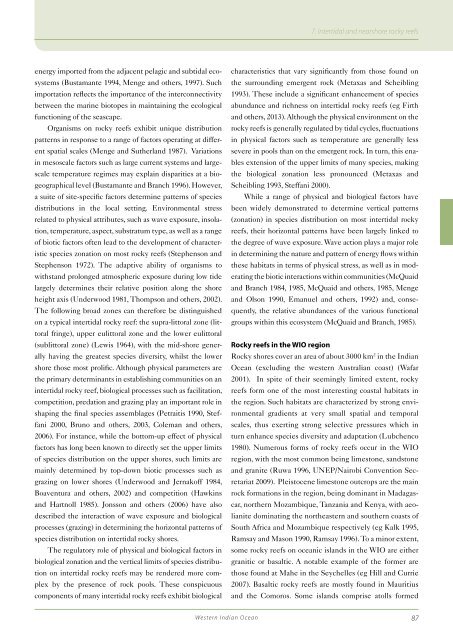WIOSOC2015_FinalDraft
WIOSOC2015_FinalDraft.pdf
WIOSOC2015_FinalDraft.pdf
You also want an ePaper? Increase the reach of your titles
YUMPU automatically turns print PDFs into web optimized ePapers that Google loves.
7. Intertidal and nearshore rocky reefs<br />
energy imported from the adjacent pelagic and subtidal ecosystems<br />
(Bustamante 1994, Menge and others, 1997). Such<br />
importation reflects the importance of the interconnectivity<br />
between the marine biotopes in maintaining the ecological<br />
functioning of the seascape.<br />
Organisms on rocky reefs exhibit unique distribution<br />
patterns in response to a range of factors operating at different<br />
spatial scales (Menge and Sutherland 1987). Variations<br />
in mesoscale factors such as large current systems and largescale<br />
temperature regimes may explain disparities at a biogeographical<br />
level (Bustamante and Branch 1996). However,<br />
a suite of site-specific factors determine patterns of species<br />
distributions in the local setting. Environmental stress<br />
related to physical attributes, such as wave exposure, insolation,<br />
temperature, aspect, substratum type, as well as a range<br />
of biotic factors often lead to the development of characteristic<br />
species zonation on most rocky reefs (Stephenson and<br />
Stephenson 1972). The adaptive ability of organisms to<br />
withstand prolonged atmospheric exposure during low tide<br />
largely determines their relative position along the shore<br />
height axis (Underwood 1981, Thompson and others, 2002).<br />
The following broad zones can therefore be distinguished<br />
on a typical intertidal rocky reef: the supra-littoral zone (littoral<br />
fringe), upper eulittoral zone and the lower eulittoral<br />
(sublittoral zone) (Lewis 1964), with the mid-shore generally<br />
having the greatest species diversity, whilst the lower<br />
shore those most prolific. Although physical parameters are<br />
the primary determinants in establishing communities on an<br />
intertidal rocky reef, biological processes such as facilitation,<br />
competition, predation and grazing play an important role in<br />
shaping the final species assemblages (Petraitis 1990, Steffani<br />
2000, Bruno and others, 2003, Coleman and others,<br />
2006). For instance, while the bottom-up effect of physical<br />
factors has long been known to directly set the upper limits<br />
of species distribution on the upper shores, such limits are<br />
mainly determined by top-down biotic processes such as<br />
grazing on lower shores (Underwood and Jernakoff 1984,<br />
Boaventura and others, 2002) and competition (Hawkins<br />
and Hartnoll 1985). Jonsson and others (2006) have also<br />
described the interaction of wave exposure and biological<br />
processes (grazing) in determining the horizontal patterns of<br />
species distribution on intertidal rocky shores.<br />
The regulatory role of physical and biological factors in<br />
biological zonation and the vertical limits of species distribution<br />
on intertidal rocky reefs may be rendered more complex<br />
by the presence of rock pools. These conspicuous<br />
components of many intertidal rocky reefs exhibit biological<br />
characteristics that vary significantly from those found on<br />
the surrounding emergent rock (Metaxas and Scheibling<br />
1993). These include a significant enhancement of species<br />
abundance and richness on intertidal rocky reefs (eg Firth<br />
and others, 2013). Although the physical environment on the<br />
rocky reefs is generally regulated by tidal cycles, fluctuations<br />
in physical factors such as temperature are generally less<br />
severe in pools than on the emergent rock. In turn, this enables<br />
extension of the upper limits of many species, making<br />
the biological zonation less pronounced (Metaxas and<br />
Scheibling 1993, Steffani 2000).<br />
While a range of physical and biological factors have<br />
been widely demonstrated to determine vertical patterns<br />
(zonation) in species distribution on most intertidal rocky<br />
reefs, their horizontal patterns have been largely linked to<br />
the degree of wave exposure. Wave action plays a major role<br />
in determining the nature and pattern of energy flows within<br />
these habitats in terms of physical stress, as well as in moderating<br />
the biotic interactions within communities (McQuaid<br />
and Branch 1984, 1985, McQuaid and others, 1985, Menge<br />
and Olson 1990, Emanuel and others, 1992) and, consequently,<br />
the relative abundances of the various functional<br />
groups within this ecosystem (McQuaid and Branch, 1985).<br />
Rocky reefs in the WIO region<br />
Rocky shores cover an area of about 3000 km 2 in the Indian<br />
Ocean (excluding the western Australian coast) (Wafar<br />
2001). In spite of their seemingly limited extent, rocky<br />
reefs form one of the most interesting coastal habitats in<br />
the region. Such habitats are characterized by strong environmental<br />
gradients at very small spatial and temporal<br />
scales, thus exerting strong selective pressures which in<br />
turn enhance species diversity and adaptation (Lubchenco<br />
1980). Numerous forms of rocky reefs occur in the WIO<br />
region, with the most common being limestone, sandstone<br />
and granite (Ruwa 1996, UNEP/Nairobi Convention Secretariat<br />
2009). Pleistocene limestone outcrops are the main<br />
rock formations in the region, being dominant in Madagascar,<br />
northern Mozambique, Tanzania and Kenya, with aeolianite<br />
dominating the northeastern and southern coasts of<br />
South Africa and Mozambique respectively (eg Kalk 1995,<br />
Ramsay and Mason 1990, Ramsay 1996). To a minor extent,<br />
some rocky reefs on oceanic islands in the WIO are either<br />
granitic or basaltic. A notable example of the former are<br />
those found at Mahe in the Seychelles (eg Hill and Currie<br />
2007). Basaltic rocky reefs are mostly found in Mauritius<br />
and the Comoros. Some islands comprise atolls formed<br />
Western Indian Ocean<br />
87


















